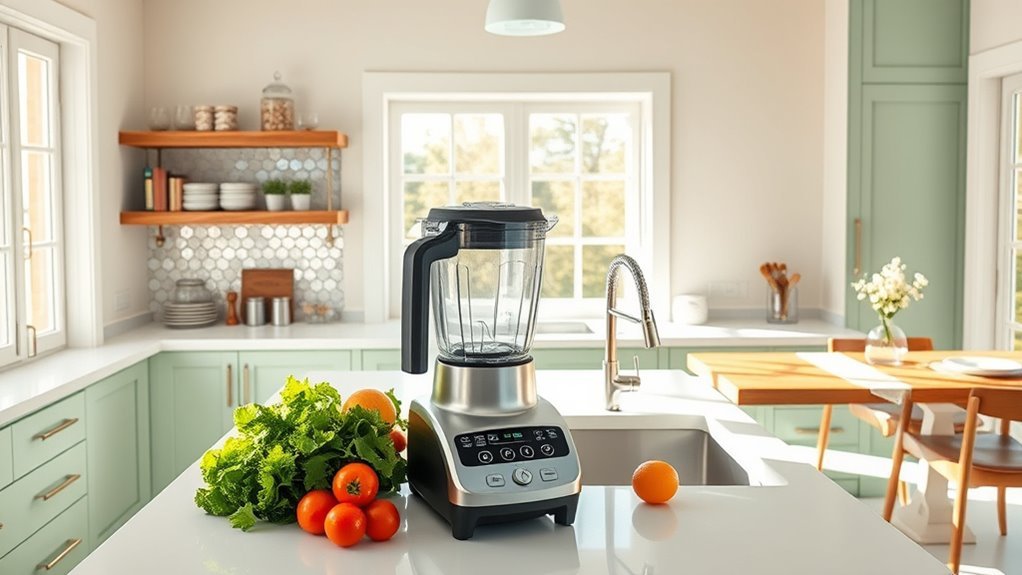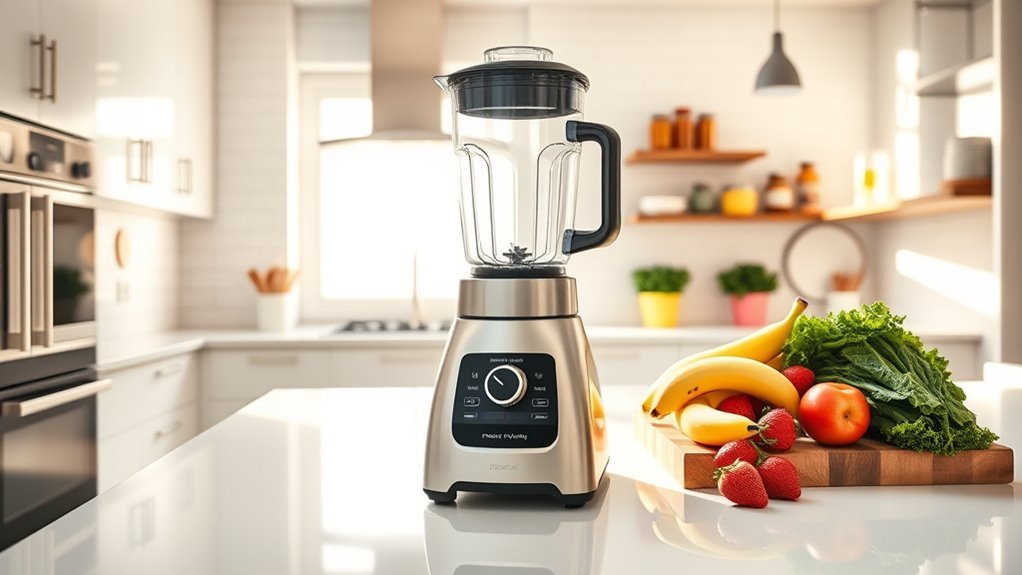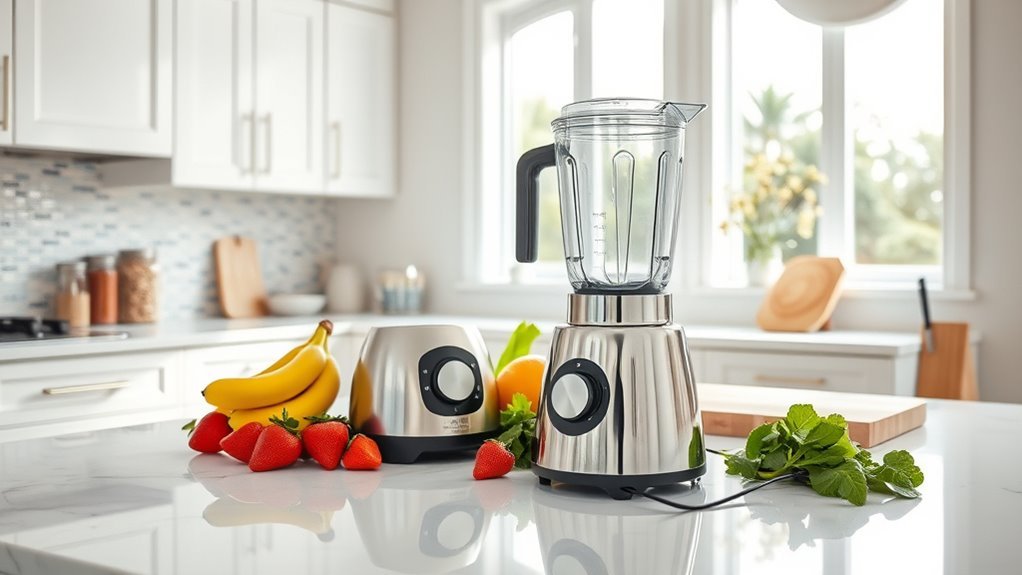We can tame noisy kitchen appliances through strategic placement and sound dampening. Position dishwashers and washing machines 2-3 inches from walls, install anti-vibration mats, and use Echo Absorber™ Natural around major noise sources. Regular maintenance prevents excess vibration – clean filters, level machines, and check for loose parts. For open floor plans, create acoustic barriers with cabinets and heavy textiles. The real magic happens when you combine these proven techniques.
Understanding Kitchen Appliance Decibel Ratings

Sound levels can make or break your kitchen’s comfort.
Let’s master decibel ratings – they’re your secret weapon for a peaceful home. Every 10 dB jump means noise is 10 times louder, so small differences matter.
We’re looking for dishwashers under 45 dB and refrigerators between 40-50 dB for quiet operation.
Think whisper-quiet to normal conversation levels. Want peace? Keep appliances away from walls and consider acoustic insulation for extra sound dampening.
Check those product specs religiously. Noise levels matter more than you’d think, especially in open floor plans.
Quiet Mark certified models are worth their weight in gold.
Remember: a 50 dB dishwasher might seem fine on paper, but it’ll echo through your living room like a drummer at midnight.
Common Sources of Appliance Noise
A kitchen’s constant hum isn’t random – it’s a symphony of specific noise sources we need to tackle. Common sources of appliance noise vary in their amount of noise, from the persistent drone of refrigerator compressors at 50 decibels to washing machines hitting 86 decibels during spin cycles.
Understanding these noisy appliances is essential before applying soundproofing materials.
- High-Impact Noise Sources: Dishwashers (44-70 dB) and washing machines dominate the soundscape, especially during drain and spin cycles.
- Continuous Background Noise: Refrigerators maintain a steady hum from fans and compressors, creating constant ambient sound.
- Intermittent Disruptions: Gas stoves’ clicking sounds and microwave operations (50-60 dB) add sporadic noise layers.
Reducing noise starts with identifying these primary culprits in your kitchen’s acoustic profile.
Effective Sound Insulation Methods

While noisy appliances might seem like an unavoidable nuisance, we’ve got powerful sound insulation methods to tame your kitchen’s acoustic chaos.
Let’s start with Echo Absorber™ Natural – it’s your first line of defense against sound reflection. Install it around those noisy culprits, and watch the decibels drop.
For floor-mounted appliances, we’re laying down Impact Barrier QT underlayment. It’s like giving your washing machine shock absorbers.
Built-in appliances? They’re your secret weapon for noise reduction. We’ll enclose those sound-makers behind cabinet walls.
Don’t forget the walls themselves – we’re sealing every joint with acoustic foam panels and mastic.
Add some heavy-duty textiles like washable rugs and cabinet curtains, and you’ll prevent noise from bouncing around. It’s science meets style, and it works.
Strategic Appliance Placement Tips
Now that we’ve got your sound insulation dialed in, let’s master the strategic placement game. Smart positioning of appliances can dramatically reduce noise transfer throughout your living space.
We’ll focus on maximizing distance from walls and using sound dampening techniques strategically.
- Position washing machines and dishwashers at least 2-3 inches from walls – this prevents sound waves from amplifying in corners and reduces vibration transfer through structural elements.
- Create acoustic barriers by installing tall cabinets or furniture between noisy appliances and living areas – they’ll block direct sound paths and minimize disturbance.
- Install built-in appliances whenever possible, using proper sound dampening materials beneath them – this approach contains noise at the source and prevents it from echoing through your kitchen.
Maintenance Practices for Noise Reduction

Regular maintenance stands as your first line of defense against noisy kitchen appliances.
Let’s tackle the essential maintenance practices that’ll keep your home appliances running quietly and efficiently.
Start by emptying dishwasher filters and cleaning refrigerator condenser coils – it’s amazing how much noise a bit of debris can create.
We’ll want to check for loose components regularly; those tiny vibrations can turn into major racket.
For your washing machine, proper leveling is non-negotiable. Trust us, an unbalanced load sounds like a helicopter taking off.
Anti-vibration mats are your secret weapon here – they’ll absorb those pesky vibrations and keep the peace.
Don’t forget to inspect seals and gaskets; when they wear out, noise reduction goes right out the window.
These simple fixes make all the difference.
Room Layout Optimization for Sound Control
Beyond maintaining your appliances, smart room layout can slash kitchen noise by up to 40%.
When planning a new kitchen, strategic placement of appliances and sound-absorbing furniture is essential for controlling the amount of sound that travels through your space.
Room layout optimization isn’t just about aesthetics – it’s about creating a peaceful environment.
- Position washing machines and dishwashers away from living areas, ideally in a separate utility room.
- Install bookshelves and upholstered furniture between noisy appliances and common areas to reduce sound transmission.
- Use dense flooring materials and wall art to absorb sound waves and prevent them from bouncing around your space.
Remember: every surface counts in sound control.
Smart placement combined with proper materials can transform your kitchen from a noise factory into a serene cooking haven.
Professional Assessment and Solutions
While DIY solutions can help reduce kitchen noise, bringing in professional expertise takes sound control to the next level. A professional assessment identifies specific noise sources and develops targeted solutions for each troublesome appliance.
We can’t overstate the value of expert acoustic evaluation. These specialists analyze your kitchen’s sound dynamics and recommend strategic modifications – from specialized insulation to structural changes that dramatically reduce noise transmission.
They’ll access advanced soundproofing materials and technologies that aren’t typically available to consumers. Plus, they’ll inspect your appliances for mechanical issues that might be causing excessive noise.
When you’re serious about creating a quieter kitchen, professional noise reduction services offer the most thorough approach. They’ll transform your noisy kitchen into a peaceful cooking haven through science-based solutions.
Frequently Asked Questions
How to Make an Appliance Quieter?
When our noisy dishwasher drove us crazy, we’d learned appliance insulation techniques like using vibration dampening materials, noise reducing modifications, strategic appliance placement, and soundproofing accessories help minimize bothersome sounds.
How to Soundproof an Appliance?
We’ll help reduce appliance noise using acoustic panels, vibration mats, and insulation materials. Let’s focus on proper appliance placement away from walls and consider adding soundproofing curtains for extra protection.
How to Reduce Noise in a Kitchen?
We’ll minimize kitchen noise by optimizing kitchen layout, strategic appliance placement, adding noise barriers like textiles, installing sound insulation in walls and floors, and choosing quiet materials for surfaces and cabinets.
What Absorbs Sound Really Well?
We’ll get great sound absorption using acoustic panels, soundproof materials like heavy curtains, and specialized noise dampening foam. For best results, combine these with vibration isolation and sound-absorbing textiles.

